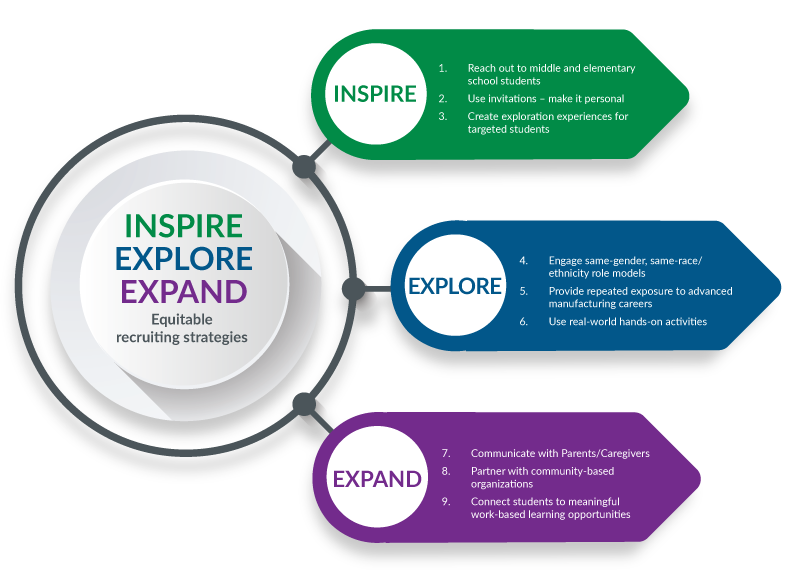Over the next decade, the United States will need to fill nearly 3.5 million advanced manufacturing jobs, but 2 million jobs may go unfilled because we do not currently have enough people trained to do them.
We are missing an opportunity to fill these in-demand jobs if we don’t find ways to attract females and underrepresented populations more effectively. The current numbers underscore the need for more targeted recruiting efforts.
- 10 percent of the advanced manufacturing workforce is black or African American
- 16.6 percent of the advanced manufacturing workforce is Hispanic or Latino
- 29% of the advanced manufacturing workforce is women.
You play a big role in shaping students’ pathways into the workforce and impacting the future of US advanced manufacturing.
Many groups, especially females, students of color, students with disabilities, English language learners, and students from low socioeconomic backgrounds are significantly underrepresented in high-skill, high-wage jobs in advanced manufacturing. These inequities exist in part due to our stereotypical way of thinking about careers. For example, nurses and elementary school teachers are often portrayed as females, mechanics as males, engineers or leaders in advanced manufacturing fields as white males. These stereotypes create hidden obstacles, but you can help break down barriers that limit females and other historically underrepresented student groups from engaging in educational pathways that can prepare them for careers in advanced manufacturing.
NAPE’s nine research-based strategies can help you confirm equitable practices you are already using, tweak approaches that could easily be transformed to attract more girls, and consider new equitable practices for your recruiting strategy. They will also help you consider how you can tailor your messaging and events to motivate girls to engage, explore and enroll. After each strategy, we point you to relevant links and resources for further reading.

First, we offer three strategies to help you inspire girls to engage. These strategies will help you inspire them to attend your recruiting events and learn more. Once you have their attention, the next step is to keep it. A big part of your job is teaching potential students about the opportunities in advanced manufacturing. We offer three strategies to help you design your recruitment events and use equitable instructional strategies. Finally, enriching the recruiting experience by engaging parents, businesses and community organizations can amplify the impact of your events and messages. We offer three strategies aimed to help you develop the key partnerships with influential people in students’ lives.
Module Materials
Best Practices: INSPIRE
- Inspire: Strategy 1: Reach out to Middle and Elementary School Students
- Inspire: Strategy 1 Resources
- Inspire: Strategy 2: Use Invitations and Make it Personal
- Inspire: Strategy 2 Resources
- Inspire: Strategy 3: Create Exploration Experiences for Targeted Students
- Inspire: Strategy 3 Resources
- Inspire: Checklist for Success
Best Practices: EXPLORE
- Explore: Strategy 4: Use Same-Gender, Same-Race/Ethnicity Role Models
- Explore: Strategy 4 Resources
- Explore: Strategy 5: Provide Repeated Exposure to Advanced Manufacturing Careers
- Explore: Strategy 5 Resources
- Explore: Strategy 6: Use Real-World Interactive Hands-On Activities
- Explore: Strategy 6 Resources
- Explore: Checklist for Success
Best Practices: EXPAND
- Expand: Strategy 7: Communicate with Parents and Caregivers
- Expand: Strategy 7 Resources
- Expand: Strategy 8: Partner with Community-Based Organizations
- Expand: Strategy 8 Resources
- Expand: Strategy 9: Connect Students to Meaningful Work-Based Learning Opportunities
- Expand: Strategy 9 Resources
- Expand: Checklist for Success

